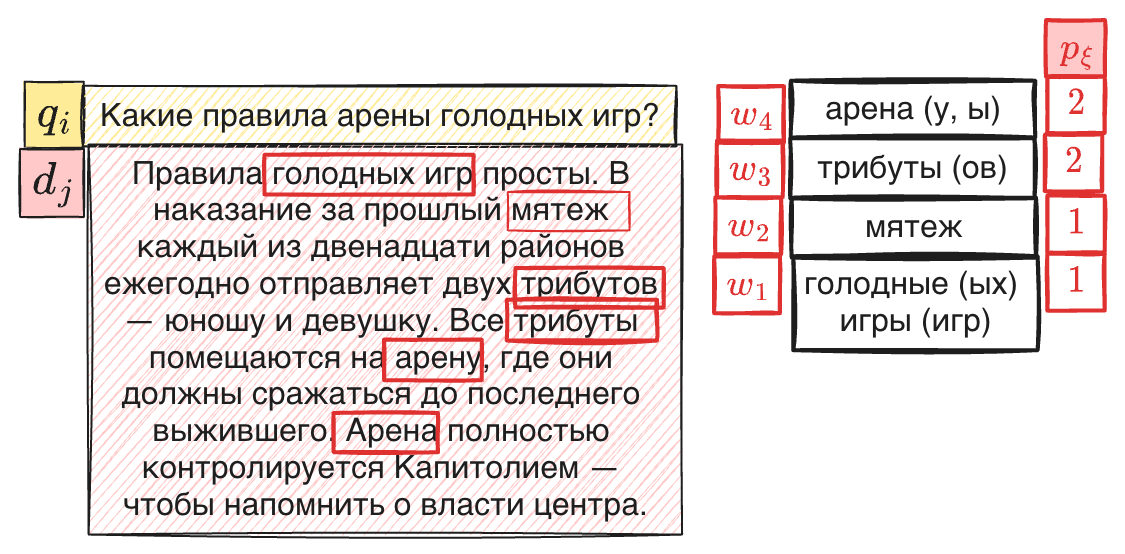IDFRecall
IDF recall ranking
Currently, to obtain the “correct” chunks (paragraphs) for a query $q_i$, different approaches are used. In practice, there are usually two:
Embedding-based search
$R_e(q_i) \mapsto {d_1, d_2, \ldots, d_k}$ — here we want to “map” vector representations of queries and paragraphs into a single Euclidean space.Keyword-based search
$R_k$, using, for example, BM25 or TF-IDF.
If you don’t know what these are, here is a resource — read it (and better yet, try it right away!).Hybrid search
\[R_h = \alpha \times R_e(q_i) + (1 - \alpha) \times R_k(q_i).\]
A combination of the first two approaches:
But what if neither approach gives a complete set of results? And you still want to provide context and retrieve keywords? In this case, you have to delve into word ranking.
Meet IDF-Recall.
Intuition: We weight all the words of the query $q_i$ and measure how strongly they cover the keywords of the paragraph (chunk).
For example, consider the query above $q_i = \text{“Какие правила арены голодных игр?”}$ and the provided paragraph $d_1$ (suppose only one document was returned):
“Правила голодных игр просты. В наказание за прошлый мятеж каждый из двенадцати районов ежегодно отправляет двух трибутов — юношу и девушку. Все трибуты помещаются на арену, где они должны сражаться до последнего выжившего. Арена полностью контролируется Капитолием — чтобы напомнить о власти центра.”
- $w_4 = \text{арена (у, ы)}$ — appears twice in the paragraph and is present in the query.
- $w_3 = \text{трибуты (ов)}$ — appears twice and is in the query.
- $w_2 = \text{мятеж}$ — appears once.
- $w_1 = \text{голодные (ых) игры (игр)}$ — appears once.
Weight of each word $w_l$ is calculated by the formula:
\[\frac{1.0}{\ln\bigl(1 + \mathrm{count}(w_l)\bigr)}.\]Then the resulting formula for calculating IDF-Recall will look like this:
Take all the “common” words $w_l \in {q_i, d_j}$. In our example, these are $w_1$ and $w_4$ — both appear in the query and are also “rare” words for the paragraph.
Take all the “keyword” words of the paragraph (you could simply treat every word as a keyword) — $w_l \in d_j$. In our example, there are four of them: $w_1, w_2, w_3, w_4$.
Calculate the “contribution” of each common word to the paragraph’s keywords.
$R_I$ (short for “IDF recall ranking”) for $(q_i, d_j)$ is defined as:
\[R_I(q_i, d_j) = \frac{\displaystyle \sum_{w_l \,\in\, (q_i \cap d_j)} \frac{1.0}{\ln\bigl(1 + \mathrm{count}(w_l)\bigr)}} {\displaystyle \sum_{w_l \,\in\, d_j} \frac{1.0}{\ln\bigl(1 + \mathrm{count}(w_l)\bigr)}}.\]In our example, it looks like this:
\[R_I = \frac{ \frac{1.0}{\ln\bigl(1 + \mathrm{count}(w_1)\bigr)} + \frac{1.0}{\ln\bigl(1 + \mathrm{count}(w_4)\bigr)} }{ \frac{1.0}{\ln\bigl(1 + \mathrm{count}(w_1)\bigr)} + \frac{1.0}{\ln\bigl(1 + \mathrm{count}(w_2)\bigr)} + \frac{1.0}{\ln\bigl(1 + \mathrm{count}(w_3)\bigr)} + \frac{1.0}{\ln\bigl(1 + \mathrm{count}(w_4)\bigr)} } \approx \frac{1}{2}.\]Which means that about half of the query’s words “cover” the important words of the document.
❗️Interestingly, if we remove the word “арены” (“arena”) from the query $q_i$, the denominator remains the same, but the numerator decreases, and the final value will be approximately 0.3.
In my tests, adding this type of ranking increases HitRate@k by an average of 5–10%. Below is an example of what happens when we use E5 (base) as the neural model $R_e$. $R_{\gamma}$ represents the search accuracy if we choose candidates and then perform additional re-ranking.
Below is the updated table with results from the polaroids.ai dataset:
| Method | HitRate@k (Polaroids.ai.Dataset) |
|---|---|
| $R_k$ | 0.49 |
| $R_e$ | 0.58 |
| $R_h$ | 0.61 |
| $R_{\gamma}$ | 0.633 |
Table 1. HitRate@k metric for the $E5_{\text{base}}$ model.
❗️If anything is unclear, feel free to reach out — I’d be happy to answer:
